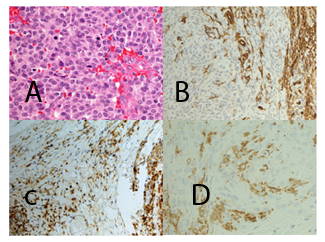Journal of
eISSN: 2574-9943


Case Report Volume 2 Issue 2
1Department of Plastic Surgery, Padua University, Italy
2Department of Pathology, Padua Hospital, Italy
Correspondence: Erica Dalla Venezia, Department of Plastic Surgery, Padua University, Italy
Received: June 28, 2017 | Published: March 9, 2018
Citation: Brambullo T, Kohlscheen E, Salmaso R, et al. Myoepithelial carcinoma of mixed cell type: a rare entity. J Dermat Cosmetol. 2018;2(2):90-92.. DOI: 10.15406/jdc.2018.02.00049
merkel-cell carcinoma, calponin, CD99, myoepithelial carcinomas, GFAP
Myoepitheliomas represent a large group of uncommon mesenchymal neoplasms characterized by myoepithelial differentiation.1
Soft tissue myoepitheliomas are histologically characterized by a wide spectrum of morphological and immunophenotypic features; the majority consists of different cell populations (i.e. epithelioid, spindled or clear cells), variably expressing epithelial markers (EMA/cytokeratin), S100 and GFAP. Spindled and epithelioid cells can be documented in different areas of the same tumor (biphasic pattern) (Figure 1), and cells with intermediate features are frequently present in the intervening zones. Neoplastic cells are organized in a solid, nested or reticular growth pattern and foci of collagenous or mixoid stroma is commonly observed.2,3 The presence of necrosis and/or a high mitotic activity are clues for the diagnosis of malignant myoepitheliomas.4 In some myoepithelial carcinomas (MECa), the cells focally have a sheet-like architecture and round cell morphology, which can create problems in differential diagnosis, particularly in the pediatric population.5 When the stromal component shows histological features of malignancy, typically osteosarcoma or chondrosarcoma, we talk of ‘myoepithelial carcinoma with heterologous (osteo) sarcomatous differentiation’ or ‘malignant mixed tumor.5‒8
Clinically, soft tissue myoepithelial neoplasms appear like long-term painless skin papule or nodule or a polypoid lesion that can be easily confused with other expansive lesions of the soft tissues. Surgery is gold standard treatment: wide excision from lateral margins extended to the deep fascia. Wide excision is mandatory, as myoepithelial carcinoma local recurrence rate is around 40% and metastatic rate is at least 30%. In children, the disease appears even more aggressive with a rate of recurrence, metastasis and mortality of approximately 50%. Chemotherapy and radiotherapy role are under discussion. We report the case of a patient who is currently followed at our clinic for a head and neck myoepithelial carcinoma of mixed cell type.
A 72-year-old Caucasian woman with unremarkable past medical history presented at our clinic for a recently enlarged greyish papula on the scalp. The neoformation developed within few months, it presented as a firm, painless, solid skin tumor of 1cm diameter without epidermal ulceration. Clinically differential diagnosis was posed with Merkel-cell carcinoma, sebaceous carcinoma and dermatofibrosarcoma protuberans.
Following surgical removal (complete excision with negative margins, R0), the histological examination disclosed spindle and epithelioid tumor cells with mitotic figures (Figure 2). Immunohistochemical staining showed positive reaction for bcl-2, calponin, cytokeratins (Figure 2B) (Figure 2C), CD99, S100, muscle-specific antigen, smooth muscle antigen and vimentin (Figure 2D). Ultrastructurally it was characterized by intermediate filaments, perinuclear tonofilaments and desmosomes (Figure 3): diagnosis of myoepithelial carcinoma of mixed cell type was established on these findings.

Figure 2 Cutaneous myoephitelial carcinoma: A) Epithelial metastasis HE staining (40x), B) Cheratine histological staining (10x), C) GFAP histological staining (10x), D) Vimentina histological staining (10x).

Figure 3 Cutaneous myoepithelial carcinoma: a: Epithelial component, 3b-3d: Sarcomatous component (all HE staining 20x;10x;10x;40x).
Local recurrence appeared after one year on the left side of surgical scar, ultrasound detected two pathological laterocervical lymph nodes of the same neck side. A CT scan showed no bone invasion. We performed wide excision of the recurrence and left superficial parotidectomy with selected modified neck dissection type III (Robbin’s levels II-IV).
Histological examination showed skin and subcutaneous hypodermic recurrence of malignant myoepithelioma and confirmed tumor localization in the pathological lymph nodes (Figure 4); sections of salivary gland and other 23 lymph nodes were free of tumor.
Reconstruction was performed with split-thickness skin graft (Figure 5). After a three years follow-up of scheduled clinical examination, associated with neck and abdomen ultrasound check, neither local nor lymph node relapse has been documented.
In 2002, the World Health Organization introduced myoepithelial tumors in the soft tissue neoplasms classification and, in 2003, Hornick et al.5 proposed criteria for malignancy. Myoepithelioma and mixed tumor are characterized by benign cytomorphology or mild cytological atypia (low-grade): when moderate atypia is presented (high-grade), the tumor can be classified as myoepithelial carcinoma (epithelioid or spindled cells with vesicular or coarse chromatin, prominent, often large nucleoli, or nuclear pleomorphism) and malignant mixed tumor (cytological malignant cartilage or bone). Hornick et al.5 published the most important series of cases and noticed equal sex prevalence and an age peak between thirty and fifty years. Malignant tumors, anyway, were more frequent and more aggressive in children. Head and neck were involved in 15% of cases, presenting as a nodule as in our case.
The MECa recurrence rate is 36.3%. The most significant univariate factors in the prediction of MECa recurrence are margin status, angiolymphatic invasion, and tumor necrosis and myoepithelial anaplasia.1 Regional lymph node metastasis and distant localizations to the lungs, skin, kidney, bone and brain have been reported in ~5% of cases. The 5 and 10-year disease specific survival rates are 93.5 and 81.8%, respectively.1 In our case, we registered a local recurrence after surgery with no involvement of the margins and a lymphatic metastasis. The surgical therapy was sufficient to obtain the complete cure and no chemotherapy or radiotherapy was performed.
As seen in our clinical case, myoepithelia carcinoma could have an ambiguous clinical behavior because of its histological features. In fact, it consists of clusters of epithelioma like and sarcomatous like cells which make this lesion complex to treat properly. Despite the morphological and histological characterization, more randomized studies are needed to outline the appropriate clinical pathway.
None.
The author declared that there are no conflicts of interest.

©2018 Brambullo, et al. This is an open access article distributed under the terms of the, which permits unrestricted use, distribution, and build upon your work non-commercially.